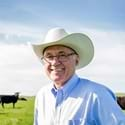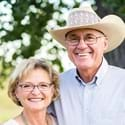Set in the High Plains region of South Dakota, Rock Hills Ranch is a family business that puts Flagship Farmer principles into action every day. By using regenerative grazing practices, the Perman family is committed to running a profitable operation while protecting a rare shortgrass prairie landscape for the future.
Across the 12,000 acres of land managed by the Permans, 10,800 acres are made up of mixed-grass prairie, an environment that forms an integral part of the cattle operation. These native grasses and habitats are key to the future sustainability of the ranch. The native flora, which has adapted over a period of several millennia, is able to withstand the unique environmental conditions – including severe drought and extreme variations in temperature. The remaining acreage comprises well-managed cover crops, wheat, corn, soybeans, perennial grass and alfalfa.
Rotational grazing
The ranch operates a rotational grazing policy, which has numerous advantages over continuous or set-stocked grazing. The system involves moving their cattle through a series of permanent pastures, which can also be further subdivided in periods of high grass growth. This system mimics the grazing pattern of buffalo, which helped form the biodiverse habitats of the plains.
McDonald’s Flagship Farmers, Lyle and Garnet Perman, and their son Luke, take a holistic approach towards ranch management, ensuring the health of the soil and grass which, in turn, ensures the health and productivity of their cattle.
Key areas of sustainable practice
Easy access to clean water is essential for cattle health and productivity, and just as important for maintaining the ranch’s rotational grazing system. With this in mind, the Permans have invested in 15 miles of piped water infrastructure and 40 large water troughs, most of which are made from recycled earth-mover tires.
The Permans focus on practices that optimize soil health in their grazing and cropping endeavors.
For cropping, the no-till practices used on the ranch are designed to keep the soil in good condition. No-till means that all crop residues remaining after harvest are left on the surface, with no plowing or cultivation undertaken that would disturb the soil. This helps to return more organic matter to the soil, as well as moderating soil temperature, minimizing wind and water erosion. Over time, this results in more worm activity and a positive impact on the soil’s vital flora and fauna.
The ranch operates a rotational grazing program known as multi-paddock adaptive grazing, which has numerous advantages over continuous or set-stocked grazing. The program involves moving cattle through 120 permanent pastures, which are further subdivided during periods of high grass growth.
Benefits of this approach include optimized forage production and intake, control of undesirable plant populations, increase in desirable plant/grass species and improved drought tolerance of pastures.
The ranch operates a form of rotational grazing known as multi-paddock adaptive grazing, where the cattle are moved through approximately 120 pastures. This mimics the movements of the vast bison herds that helped create the biodiverse habitats of the plains before settlers arrived in the 19th century. In this grazing system, nutrients are cycled in the manure and different plants are grazed throughout the year, avoiding overgrazing and enabling a variety of native, beneficial species to flourish.
The grasses and other species that the Perman family works to protect and preserve have developed over thousands of years and are perfectly adapted to withstand the drought and extreme temperatures of the area.
The Permans work in partnership with many organizations to improve knowledge and practice. They share this learning through an outreach program for the local community and educational visits for youth groups.
As a further commitment to a sustainable farming future, the ranch offers a technical internship in grazing, herd health and habitat management, and a cultural internship focused on skills in growing vegetables and cooking.
In 2014, the Permans developed the “100th Meridian Trail” (named because the ranch is located on the 100th meridian). The walking trail offers half-mile to five-mile hikes, and has engraved rocks with cultural information and a printed brochure. Participants access the trail and markers using a hand-held GPS unit provided by the ranch. These efforts help the ranch to tap into natural and cultural resources and generate income to help keep the ranch sustainable.
The Permans see themselves as stewards of the land and animals in their care, but also know that their ranch must be profitable to survive and thrive.
In addition to minimizing their inputs by maximizing the full potential of their native grasses and pastures, the ranch also seeks out specialty markets to augment their traditional beef production. The ranch is currently cross-breeding a number of Angus cows with Wagyu or Akaushi sires to produce specialized calves sought out by a higher-income market, increasing the farm’s revenue.
The family believes in maintaining a self-supporting business with resources and production systems designed to be both environmentally sustainable and profitable. Encouraging innovation, optimizing production and reducing waste are all key to this economic viability.
The ranch’s dam line is an Angus, which is being crossed to a terminal Wagyu sire. This breeding has increased the hybrid vigor of calves, in turn reducing mortality and morbidity rates while improving carcass grades at slaughter.
A selection of best-quality home-bred Angus females are retained and crossed with an Angus sire to produce replacement heifers for the herd, helping improve herd genetics and maintain a high herd health status.
Learn more about Lyle and Garnet Perman’s story at Rock Hills Ranch
Explore the case study, where you’ll find additional details on how Rock Hills Ranch has aligned with the Flagship Farmers Program’s key areas of sustainable practices, what external research reveals about the producer’s actions and how improved sustainability is benefiting them.

“We want to be good stewards of what we have been blessed with. Of course, we need to be profitable to be sustainable, but it cannot be to the detriment of our environment or to our community. By always evolving and improving, we believe we can show what is possible through our example.”








